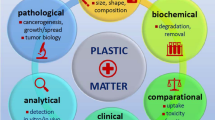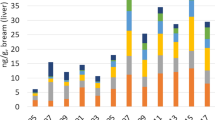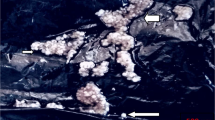Abstract
Faecal excretion is a basic means of detoxification upon ingestion of Pb-contaminated feed. In order to determine a time course of Pb elimination after oral exposure to two different forms of this heavy metal (lead acetate vs. phyto-bound Pb), a feeding study was carried out in experimental rats using the Pb phyto-hyperaccumulator Pistia stratiotes as a model diet. The effect of starvation on Pb excretion was further studied in rats that were fed plant material. Twelve Pb doses (7 μg Pb/1 g BW) were administered orally over a 5-week period. Faeces samples were collected 24 and 72 h post-exposure. Inductively coupled plasma optical emission spectrometry and electrothermal absorption spectrometry methods were used for determination of heavy metal concentrations. Up to 53 % of ingested Pb was rapidly eliminated from the exposed rats via faeces within 24 h after exposure. Faecal excretion in exposed rats differed significantly when compared to that of the control group. Fasting before exposure reduced Pb excretion by up to 50 %. Faecal excretions of both examined Pb forms exhibited almost identical patterns. Considerable differences were revealed concerning total excretion levels; lead acetate was excreted in amount greater extent than those of phytobound Pb. Results of our study suggest that Pb forms occurring in the P. stratiotes tissues are absorbed through the gastrointestinal tract to a greater extent than Pb from lead acetate. Therefore, higher portions of ingested Pb can be available for potential accumulation in tissues of exposed subjects.


Similar content being viewed by others
References
United Nations Environment Programme (2010) Annual report 2010. http://www.unep.org/annualreport/2010/pdfs/HARMFUL-SUBSTANCES.pdf. Accessed 30 June 2012
Angelova VR, Ivanova RV, Todorov JM, Ivanov KI (2010) Lead, cadmium, zinc, and copper bioavailability in the soil–plant–animal system in a polluted Area. Scientific World J 10:273–285
WHO (2002) Lists of priority contaminants and commodity combinations. http://euro.who.int/foodsafety/Chemical/20020816_7WHO/EHC. Accessed 20 June 2012
Wilkinson JM, Hill J, Phillips CJC (2003) The accumulation of potentially-toxic metals by grazing ruminants. Proc Nutr Soc 62(2):267–277
Liu ZP (2003) Lead poisoning combined with cadmium in sheep and horses in the vicinity of non-ferrous metal smelters. Sci Tot Environ 309:117–126
Skalicka M, Korenekova B, Nad P (2002) Lead in livestock from polluted area. Trace Elem Electrolytes 19:94–96
Mishra VK, Upadhyay AR, Pandey SK, Tripathi BD (2008) Concentration of heavy metals and nutrient in water sediments and aquatic macrophytes of GBP Sagar. Environ Monit Assess 141:49–58
Prasad MNV, Freitas HMO (2003) Metal hyperaccumulation in plants—biodiversity prospecting for phytoremediation technology. Electron J Biotechnol 6(3):285–321
Wu WB, Sun YL (2011) Dietary safety evaluation of water hyacinth leaf protein concentrate. Hum Exp Tox 30(10):1514–1520
Ayoade GO, Sharma BH, Sridhar MKC (1982) Trials of Pistia stratiotes L. as animal feed. J Aquat Plant Manag 20(1):56–57
Espinoza-Quiñones F, Módenes A, Costa I, Palácio S, Szymanski N, Trigueros D, Kroumov A, Silva E (2009) Kinetics of lead bioaccumulation from a hydroponic medium by aquatic macrophytes Pistia stratiotes. Water Air Soil Pollut 203:29–37
Odjegba VJ, Fasidi IO (2004) Accumulation of trace elements by Pistia stratiotes: implications for phytoremediation. Ecotoxicology 13(7):637–646
Vesely T, Tlustos P, Szakova J (2011) Organic salts enhanced soil risk elements leaching and bioaccumulation in Pistia stratiotes. Plant Soil and Environment 57(4):166–172
O’Flaherty EJ (1993) Physiologically based models for bone-seeking elements. IV. Kinetics of lead disposition in humans. Toxicol Appl Pharmacol 118:16–29
Rabinowitz MB, Wetherill GW, Kopple JD (1976) Kinetic analysis of lead metabolism in healthy humans. J Clin Inves 58:260–270
Kaushal D, Garg ML, Bansal MR, Bansal MP (1996) Biokinetics of lead in various organs of rats using radiotracer technique. Biol Trace Elem Res 53(1–3):249–260
O’Flaherty EJ, Inskip MJ, Yagminas AP, Franklin CA (1996) Plasma and blood lead concentrations, lead absorption, and lead excretion in nonhuman primates. Toxicol Appl Pharm 138(1):121–130
Rabinowitz MB, Kopple JD, Wetherill GW (1980) Effect of food intake on fasting gastrointestinal lead absorption in humans. Am J Clin Nutr 33:1784–1788
Arai F, Yamauchi H, Chiba K, Yoshida K (1998) Excretion of triethyllead, diethyllead and inorganic lead in rabbits after injection of triethyl neopentoxy lead. Ind Health 36(4):331–336
Faix S, Faixova Z, Boldizarova K, Javorsky P (2005) The effect of long-term high heavy metal intake on lipid peroxidation of gastrointestinal tissue in sheep. Vet Med-Czech 50(9):401–405
Parker GH, Hamr J (2001) Metal levels in body tissues, forage and fecal pellets of elk (Cervus elaphus) living near the ore smelters at Sudbury, Ontario. Environ Pollut 113(3):347–355
Bersenyi A, Fekete S, Hullar I, Kadar I, Szilagyi M, Glavits R, Kulcsar M, Mezes M, Zoldag L (1999) Study of the soil–plant (carrot)–animal cycle of nutritive and hazardous minerals in a rabbit model. Acta Vet Hungar 47(2):181–190
Fekete SG, Bersenyi A, Kadar I, Glavits R, Koncz J, Zoldag L (2001) Study of soil–plant (potato and beetroot)–animal cycle of nutritive and hazardous minerals in a rabbit model. Acta Vet Hungar 49(3):301–310
Castellino N, Aloj S (1964) Kinetics of the distribution and excretion of lead in the rat. Brit J Ind Med 21:308–314
Gregus Z, Klaassen CD (1986) Disposition of metals in rats: a comparative study of fecal, urinary, and biliary excretion and tissue distribution of 18 metals. Toxicol Appl Pharmacol 85:24–38
Mader P, Száková J, Miholová D (1989) Classical dry ashing of biological and agricultural materials. Part II. Losses of analytes due to their retention in an insoluble residue. Analusis 26:121–129
Farmer AA, Farmer UM (2000) Concentrations of cadmium, lead and zinc in livestock feed and organs around a metal production centre in eastern Kazakhstan. Sci Tot Environ 257:53–60
Directive 2002/32/EC of the European Parliament and of the Council of 7 May 2002 on undesirable substances in animal feed.
National Research Council (1980) Recommended dietary allowances, 9th edn. National Academy Press, Washington DC
Hunder G, Javdani J, Elsenhans B, Schumann K (2000) Use of gamma-spectrometry for simultaneous determination of Pb-210, As-73, Cd-109, Hg-203 and Fe-59 distribution and excretion in rats. Toxicology 150(1–3):69–82
Reeves PG, Vanderpool RA (1998) Organ content and fecal excretion of cadmium in male and female rats consuming variable amounts of naturally occurring cadmium in confectionery sunflower kernels (Helianthus annuus L). J Nutr Biochem 9(11):636–644
Phillips CJC, Chiy PC, Zachou E (2005) Effects of cadmium in herbage on the apparent absorption of elements by sheep in comparison with inorganic cadmium added to their diet. Environ Res 99(2):224–234
Aungst BJ, Doice JA, Fung HL (1981) The effect of dose on the disposition of lead in rats after intravenous and oral administration. Toxicol Appl Pharm 61:48–57
Heard MJ, Chamberlain AC (1982) Effect of minerals and food on uptake of lead from the gastrointestinal tract in humans. Hum Toxicol 1:411–416
Blake KCH, Barbezat GO, Mann M (1983) Effect of dietary constituents on the gastrointestinal absorption of 203 Pb in man. Environ Res 30:182–187
Steinbaugh GE, Taylor RW, Pfeiffer DR (2007) Oral administration versus intra-peritoneal injection of Pb affects its concentration in selected rat tissues. Inorg Chem Commun 10(11):1371–1374
Schat H, Llugany M, Vooijs R, Hartley-Whitaker J, Bleeker PM (2002) The role of phytochelatins in constitutive and adaptive heavy metal tolerances in hyperaccumulator and non-hyperaccumulator metallophytes. J Exp Bot 53(379):2381–2392
Rascio N, Navari-Izzo F (2011) Heavy metal hyperaccumulating plants: how and why do they do it? And what makes them so interesting? Plant Science 180(2):169–181
Callahan DL, Baker AJM, Kolev SD, Wedd AG (2006) Metal ion ligands in hyperaccumulating plants. J Biol Inorg Chem 11(1):2–12
Sharma NC, Gardea-Torresdey JL, Parsons J, Sahi SV (2004) Chemical speciation and cellular deposition of lead in Sesbania drummondii. Environ Toxicol Chem 23(9):2068–2073
Sarret G, Vangronsveld J, Manceau A, Musso M, D’Haen J, Menthonnex JJ, Hazemann JL (2001) Accumulation forms of Zn and Pb in Phaseolus vulgaris in the presence and absence of EDTA. Environ Sci Technol 35(13):2854–2859
Garber BT, Wei E (1974) Influence of dietary factors on gastrointestinal absorption of lead. Toxicol Appl Pharm 27(3):685–691
Barltrop D, Khoo HE (1975) Influence of nutritional factors on lead absorption. Postgrad Med J 51(601):795–800
Acknowledgments
The authors gratefully acknowledge Brian Kavalir (Ontario, Canada) for his proofreading services.
Funding Source
This study was financially supported by the university-wide internal grant agency of the Czech University of Life Sciences, Prague no. 20112034.
Ethical Standards—Experimental Animals
All experiments with laboratory animals were conducted in compliance with the current laws of the Czech Republic Act No. 246/1992 coll. on Protection Animals against Cruelty and EC Directive 86/609/EEC. Animal care was supervised by authorised person: Zuzana Čadková, holder of the Central Commission for Animal Welfare Certificate no. CZ 00354.
Author information
Authors and Affiliations
Corresponding author
Rights and permissions
About this article
Cite this article
Čadková, Z., Száková, J., Miholová, D. et al. Faecal Excretion Dynamic during Subacute Oral Exposure to Different Pb Species in Rattus norvegicus . Biol Trace Elem Res 152, 225–232 (2013). https://doi.org/10.1007/s12011-013-9609-8
Received:
Accepted:
Published:
Issue Date:
DOI: https://doi.org/10.1007/s12011-013-9609-8




